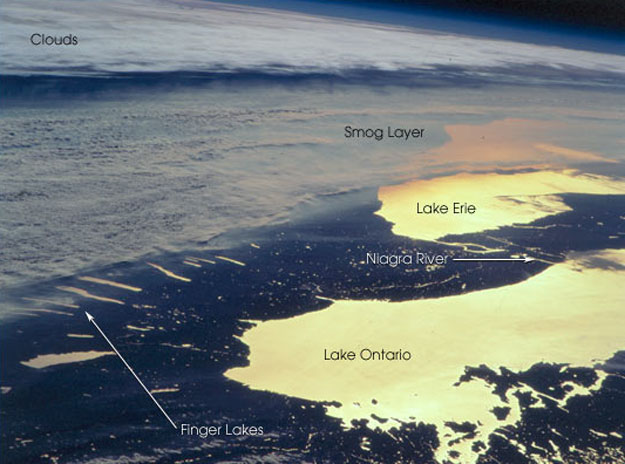
Countdown to Earth Day
April 9, 2004

Smog over New York. Photo credit: NASA
“When the Russian cosmonaut tells me that the atmosphere over Lake baikal is as polluted as it is over Europe, and the American astronaut tells me that 15 years ago he could take much clearer pictures of the industrial centers than today, then I am getting concerned.”
- Ernst Messerschmid
Germany, 1988
Combustion processes, whether for industrial manufacturing or for power generation, release sulfur oxides, sulfates, nitrous oxides, mercury and other heavy metals, as well as toxic organic compounds. While control technologies exist which can result in dramatic reductions of emissions from coal-fired power plants, they are installed only on the newest facilities. Retro-fitting older power plants would make them uneconomic to operate. Instead we have in place in the U.S. a system for trading pollution “credits”. Plants who’s emissions are significantly below the allowed limits can sell their pollution credits to power plants that are unable to meet the limits. The net result is a gradual reduction in emissions nationwide - although no improvement may be seen locally until an outdated plant is closed or modernized.
Pollution control technologies may be improving for American factories and power plants, but those same standards are not applied in other parts of the world. Whether controlled or not, the problem with airborne pollutants is that the atmosphere does not recognize state or national boundaries.
Sulfur and nitrogen compounds released by coal-fired power plants in the Midwest have resulted in acidic rainfall and degradation of lakes and forests in New England and Canada. Fine particles and aerosols from volcanic eruptions can circle the globe within days. Soot dating back to the start of the Industrial Revolution has been identified in ice cores from the Greenland and Antarctic ice caps. High above the Arctic Circle scientists have discovered that polar bears in this remote region are heavily contaminated with industrial chemicals. We all breathe the same air, and pollution, wherever in the world it originates, affects us all.
And it’s not just what’s getting in our lungs that should concern us. High overhead, at the top of the stratosphere the air contains trace levels of ozone (a molecule comprising three oxygen atoms). This ozone helps filter out harmful ultra violet rays from the sun before they can reach the Earth’s surface. About 30 years ago atmospheric scientists began noticing that the ozone layer over the north and south poles was becoming thin at certain times of the year and allowing increasing amounts of ultraviolet radiation to reach the surface. Research showed that this thinning was caused by the presence in the atmosphere of a group of compounds known a chlorofluorocarbons - CFCs for short. CFCs were one of the miracle products of the late 20th Century - non-toxic, non-reactive, and with very attractive chemical properties. They were used as propellants in aerosol cans, and as coolants in our refrigerators and air conditioners. They also had several unforeseen characteristics - they stayed around a long time, and they got into the upper atmosphere where they wreaked havoc on the ozone layer. So great was the concern about destruction of the ozone layer that 172 nations in 1987 signed the Montreal Protocol which set a timetable for phasing out the use of CFCs and other ozone-depleting chemicals. However, while the manufacture of harmful CFCs has essentially stopped in this country, they are still manufactured overseas. Also, the world retains a huge stockpile of the chemicals and their use continues. Thus, the “holes” in the ozone layer continue to be an annual event, getting bigger and lasting longer each year.
Learn more about ozone depletion at:
http://www.faqs.org/faqs/ozone-depletion/
Learn more about particulate pollution (soot, dust, smog) at the American Lung Association’s web site:
http://lungaction.org/campaign/NAAQS/explanation
The American Lung Association also hosts the Clean Air Standards web site which has information on other toxic air pollutants and how to reduce them:
http://www.cleanairstandards.org/
While focused on California, the Clean Air Coalition’s facts about air pollution are applicable to other regions as well:
http://www.coalitionforcleanair.org/cca/facts.htm